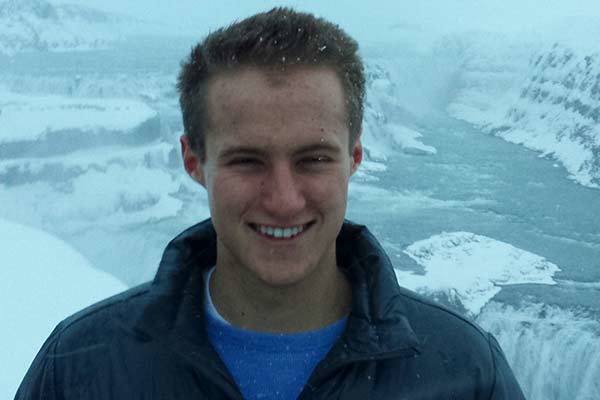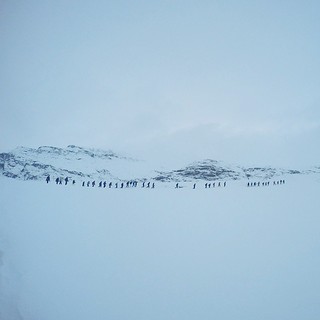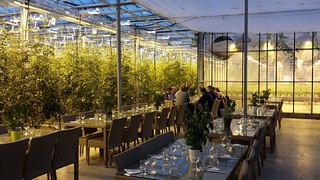
What can an engineer learn by traveling to Europe? Ryan Schools ('17), a Chemical and Biomolecular Engineering major, thought that he had a lot to learn from Icelandic models of sustainability and renewable energy, and he was right! As humanity strives to untangle and address global environmental change, Ryan recognized that doing so requires experiencing and learning from other cultural and national models of sustainable practice and industry. We agreed, and gave him a Break Travel and Research Grant for Sophomores and Juniors to travel to Reykjavik, Iceland. He recently wrote to us about his experience, and sent us some stunning photos!
It’s not often that one is faced with the opportunity to travel to the actual ends of the Earth in the name of research, adventure, and personal growth, but that’s exactly the kind of circumstance I was presented with over this past winter break. Thanks in part to the support of Notre Dame’s Nanovic Institute for European Studies, I was able to travel to remote Iceland for 8 days as a part of the “Global Renewable Energy Educational Network”, otherwise known as the GREEN Program. The GREEN Program is an award-winning, experiential education and professional development program that strives to provide student leaders from around the world with an immersive and comprehensive look at the cutting edge of global sustainable practice and industry—a goal which tends to necessitate travel to some of the most unique destinations in the world.
The GREEN Program in Iceland partners with the innovative Reykjavik University School of Energy as well as leading Icelandic energy companies to deliver world-class education on renewable energy, first-hand. Whether it’s taking classes taught by actual Reykjavik University professors, touring some of Iceland’s state-of-the-art hydro and geothermal power plants, or even chatting with one of the humble Icelandic farmers that are pushing the envelope on sustainable agricultural practice, the GREEN program truly offers something for everyone and provides a once-in-a-lifetime chance to experience a way-of-life seemingly born of the future. The program also prides itself on a strong commitment to adventure, cultural immersion, and unconventional education, and thus includes opportunities to participate in a series of unforgettable and “uniquely Icelandic” activities ranging from glacier hiking to hot spring swimming.
I first became interested in the GREEN program because it represented a way to pursue my interests in the energy sector while also experiencing a part of the world that faces challenges very different from our own. As a chemical engineering major interested not only in the intersection of novel technologies with responsible and sustainable practice, but also in the idea of adventuring to the far corners of the world, GREEN was a perfect fit for me, and it lended itself wonderfully to the spirit of the Nanovic Institute’s break research and travel grants.

One of the major components of the GREEN Program is a “green” capstone project that sees participants form teams to develop an idea or model incorporating the lessons learned throughout the program into a final presentation given at Reykjavik University. Knowing from the beginning that the capstone project would make up the majority of the research and application-based thinking I would do during my time in Iceland, I thought a lot before the trip began about how I might be able to shape the project to address some of my most fundamental questions about sustainability. Beyond simple thoughts I had about how geothermal power plants work or how the Icelandic public feels about hydrogen cars, I was interested more than anything else in exploring the factors that contribute to making renewable technologies feasible and preferable over other types of conventional solutions. In effect, I wanted to take from Iceland a better knowledge of how its renewable success story might be extended to other sites around the world, and of how that story might need to be adjusted and even overturned to meet the unique constraints and issues of those locales.

Despite being somewhat limited by time and resources, each and every group on my GREEN program produced a capstone that targeted a meaningful and significant issue and proposed an innovative plan to move toward its solution. To use my own group’s capstone as an example, my groupmates and I chose to work with the relatively underappreciated problem surrounding lithium-ion battery recycling. Right now, there are approximately 2 billion lithium-ion batteries discarded every year by consumers of phones, computers, electric vehicles, and other devices around the world, and that number will only continue to grow in the coming years. Due to the expenses surrounding the delicate process of actually breaking down and recycling these batteries, it turns out there is virtually zero infrastructure currently available for their efficient and safe disposal, which leaves the vast majority of them to pile up in the hands of consumers, electronics retailers, and, regrettably, landfills.

In an attempt to remedy this problem or to at least control it before it grows to become an even more pressing environmental threat, our group produced a business model for a series of automated and versatile lithium-ion battery recycling centers that could feasibly overcome the current economic barriers to the U.S. market in the very near future. Bringing together knowledge on the finances and other nuances of renewable technologies, operations, and systems that we learned about through GREEN with my own, original intention to spread Icelandic-inspired sustainable solutions, the project was a huge success, and, to me, represented the culmination of what the GREEN program is all about: recognizing that the world really can be changed despite the status quo.

Overall, my experience in Iceland with GREEN was nothing short of unbelievable from start to finish. Not only was I given access to brilliant minds, world-class operations, and unforgettable excursions, but I was able to learn more about myself, my passions, and the world around me while working toward a very real piece of the renewable solution. Even beyond the academics of GREEN, the program truly encompassed so much more than words can describe. Participants in GREEN come from all kinds of backgrounds, cultures, and upbringings, but are intrinsically united by their curiosity and their care for our planet and society. As such, in only 8 short days, I was bestowed with 42 amazing new friends who compose a network reaching to the far corners of the world, and who all share in my hopes and passions for a greener tomorrow. All of these things—the memories, the experiences, the knowledge, the accomplishments, the friends, and more—I owe to the Nanovic Institute and to Notre Dame, and for that I’d like to say “þakka þér.”